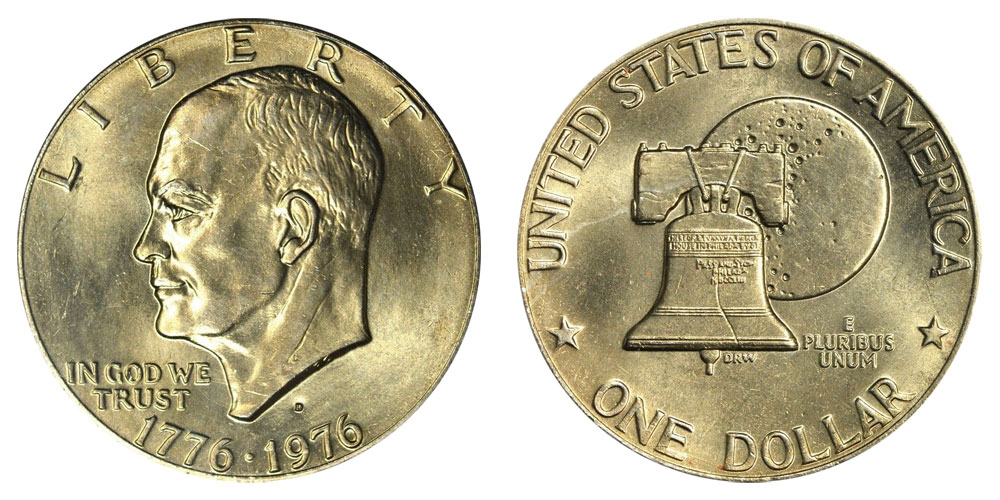Eisenhower Dollar
The Eisenhower Dollar was issued from 1971 to 1978. The obverse of the coin features Dwight D. Eisenhower and the reverse is based on the Apollo 11 mission insignia. For circulation, the coins were struck in copper-nickel clad composition, although “silver dollars” were also produced and issued for collectors. Despite the short duration of the series, the different compositions, varieties, and conditional rarities provide complexity and challenge for collectors.

The United States Mint Produced the Eisenhower dollar from 1971 until 1978 when the Treasury Department replaced it with the Susan B. You can learn about years, strike type, the mint facility where struck, the mint mark used on the coin and a description of any type differences in coins minted for that year. The Eisenhower dollar was the first US dollar coin struck since the 1935 Peace dollar. It was conceived to honor the recently deceased President Dwight D. Eisenhower and designed by Frank Gasparro. Due to a rise in bullion prices the majority of Eisenhower dollars were produced with base metals. The collector-grade coins were minted with 40% silver and 60% copper, owing to its low silver weight of 0.3162 troy.
The production of dollar coins had entered a lengthy hiatus after the final Peace Dollars were struck in 1935. By this time, the required production under the Pittman Act had been completed and abundant supplies were stockpiled which would last for decades. The denomination almost made a come back in 1964 when Congress authorized the production of new silver dollars, however, the entire quantity produced was recalled and melted before issuance. In the following year, the Coinage Act of 1965 would eliminate the silver content from circulating US coins and forbid the minting of silver dollars for a period of five years.
Following the conclusion of the five year period, the first legislation to create a new dollar coin was introduced in October 1969. The legislation sought to create a circulating dollar coin which would commemorate Dwight D. Eisenhower who had died earlier that year and the Apollo 11 space flight, which marked man’s first steps on the moon. A modified bill was eventually passed on December 31, 1970.
Eisenhower Dollar

The Chief Engraver for the United States Mint Frank Gasparro designed both the obverse and the reverse of the coin. The obverse bore a profile bust of Eisenhower with inscriptions “Liberty”, “In God We Trust”, and the date. To prepare the design, Gasparro studied 30 pictures of the former President and Five Star General as well as a drawing he had made in 1945 after catching a glimpse of Eisenhower at a parade in 1945.
The reverse of the coin was based on the mission insignia from the Apollo 11 space flight. This was deemed particularly appropriate by Congress since the space program began under Eisenhower’s administration. The reverse design featured a bald eagle landing on the surface of the moon, carrying an olive branch, with the Earth visible in the background from space.
Eisenhower Dollar Collection
The new Eisenhower Dollars would first be issued for circulation on November 1, 1971. A few months earlier on July 1, uncirculated and proof versions struck in 40% silver were be available for collectors.
A different reverse design was introduced for the 1976 Eisenhower Dollar to celebrate the bicentennial of the American Revolution. The design by Dennis R. Williams featured an image of the Liberty Bell and the moon. The second element paid tribute to Gasparro’s original design, while the bell was included as a symbol of the liberty and freedom. The bicentennial reverse appeared on coins minted during 1975 and 1976, which all carried the dual date of “1776-1976” on the obverse.
Eisenhower Dollars were struck for circulation using the copper-nickel clad composition, which was also used for circulating dimes, quarters, and half dollars. The composition consisted of an outer layer of 75% copper and 25% nickel, bonded to a core of pure copper. The resulting net composition was 91.67% copper and 8.33% nickel.
Eisenhower Dollar 1776 1976
As provided by the authorizing legislation, Eisenhower Silver Dollars were struck for collectors. Initially, a quantity of 150 million silver dollars was authorized for production over four years. These coins had an outer layer of 80% silver and 20% copper and an inner layer of 40% silver and 60% copper. The resulting net composition was 40% silver and 60% copper, with silver content of 0.3161 troy ounces. Authorization was later provided to produce bicentennial coins with the same composition.